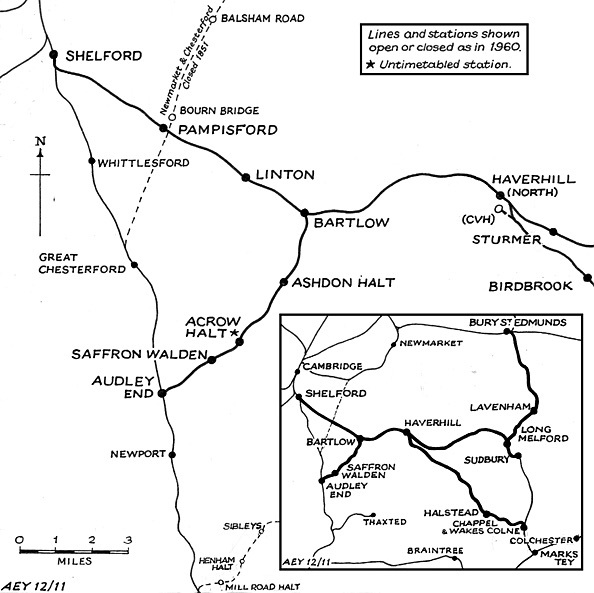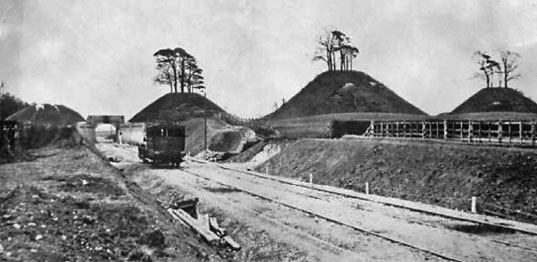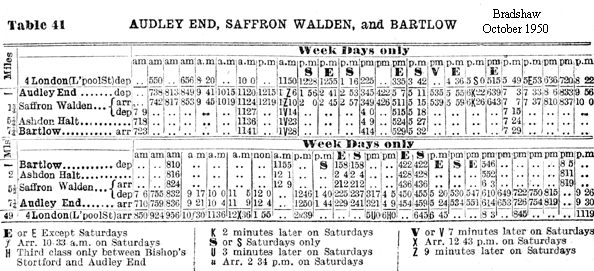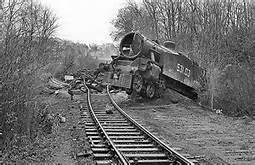Gilly Cunningham looks at the history of the two lines that met at Bartlow Junction:

The Stour Valley Line – Colchester to Cambridge
The Beginning - After power struggles, acquisitions and mergers between the Colne Valley Railway Company, the Eastern Union Railway Company and the Eastern Counties Railway Company, the Great Eastern Railway Company consumed them all and was able to extend the existing Stour Valley Line to complete the link between Cambridge and Colchester. The stretch between Bartlow and Haverhill proved extremely taxing to the engineers because of the gradient. It opened in 1865 and the Cambridge Chronicle reported “The Bartlow Hills were literally (sic) alive and many a hearty cheer was given for the success of the line”.
The original footbridge which crossed the main line via the tumuli is intact and still in daily use – not by commuters now but by dog walkers and ramblers. It linked the main village to the station – Bartlow Junction - on the Ashdon Road. Only the brick abutments survive of the bridges that carried the line over Ashdon Road to the station and then over the Hadstock Road and on to Linton and Cambridge.
In her account of her life in the village at the turn of the 19th/20th century, Violet Murkin recalls soldiers returning from the Boer War using the line. It was also used by soldiers in both World Wars and by evacuees. Some people currently living in the village can recall using the line.
The End – However, the line never really recovered from the 1924 Rail Strike and the 1926 General Strike which dampened public enthusiasm for railways. After a brief recovery in the 1930s when holiday makers and ramblers used the line, it went the way of other rural lines. By the early nineteen-sixties it was losing £26,000 a year. Dr. Beeching swung his axe and the last train ran on the line on 4th March, 1967.
And the Damage – During the cutting of the main line in 1865, damage was caused to the Romano/British tumuli site as the line was routed between two of the hills. As you walk onto the footbridge leaving the site of the remaining three hills you can see what is left of another hill on your right just within the boundary of Bartlow Park.
Vague references exist to skeletons of the Romano/British period having been accidently exhumed by these engineering works but there does not seem to be any evidence of recording or cataloguing the finds of this 1865 ‘dig’. Perhaps further investigation of this internationally important archeological site would have held up the construction process!
Saffron Walden Branch Line – Bartlow to Saffron Walden
The Beginning - The original plan for the London/Cambridge railway cut through Saffron Walden. However, Lord Braybrooke insisted that the route be moved nearer to his home at Audley End. Fearing economic decline if the Town was isolated from the railway, Saffron Walden Town Council called a public meeting to discuss building a branch line to connect the Town with the main line. The Saffron Walden Railway Company was born. Funds were raised and the necessary Act of Parliament was given assent in 1861. By the time work started it had been agreed that the branch line should be extended to link it with the Stour Valley main line at Bartlow Junction. The extension opened in 1866 and the line was purchased by Great Eastern Railways in 1877.
The line’s fortunes fluctuated over the years doing best during wartime. In 1923 the line was absorbed into London & North Eastern Railways. During the Second World War it carried troops, evacuees and freight as petrol rationing restricted road transport but after the War passenger numbers dropped again and freight returned to the road.
However, five trains a day continued to link Bartlow, Ashdon Halt (added 1911), Acrow Halt, Saffron Walden and Audley End. At least one current Bartlovian can recall using this line to commute to and from school. There were even some direct trains from Bartlow to London!
The End - In 1958 diesel-fuelled railcars replaced the Victorian coaches and continued to trundle up and down the line until Dr. Beeching’s report lead to its closure in 1964…….only to reopen very briefly in 1968 when a stretch of the track in Bartlow became Malaya for the filming of the train crash scene in Virgin Soldiers starring Lynn Redgrave and Hywel Bennett.




